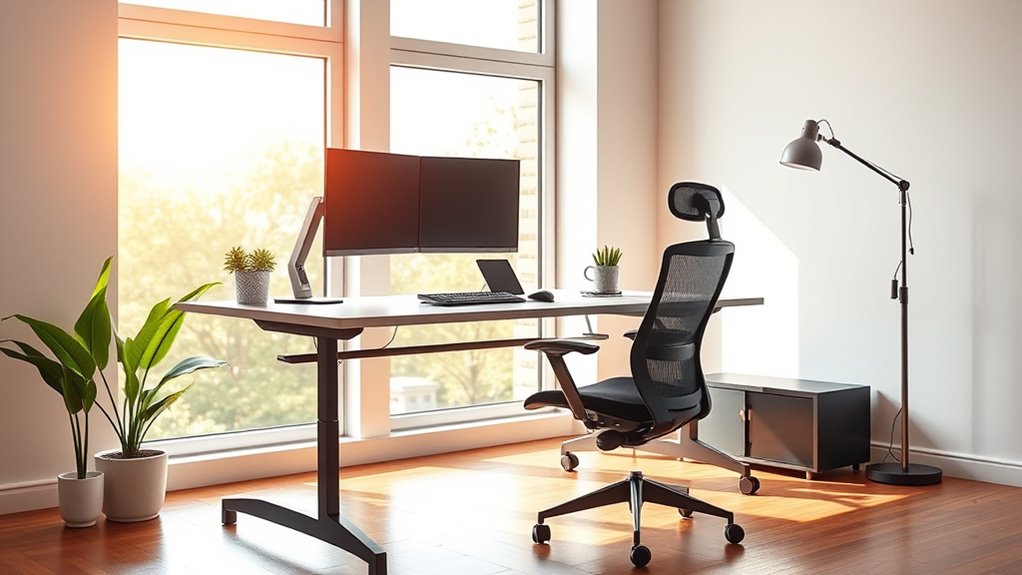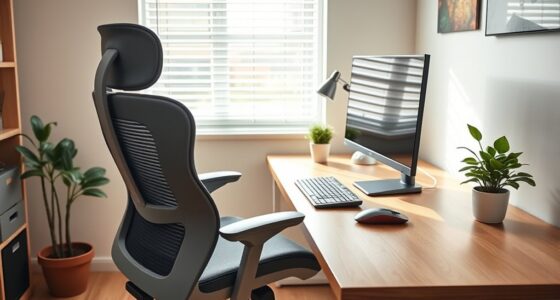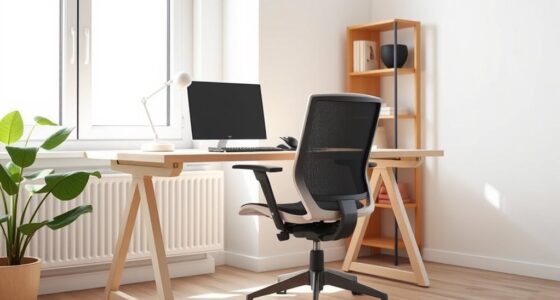To create an ergonomic home office, start by evaluating your space and setting a realistic budget. Choose a supportive, adjustable desk and chair, ensuring proper placement for your monitor and keyboard to promote good posture. Incorporate suitable lighting and frequent movement throughout the day. Add ergonomic accessories like wrist supports and personalize your workspace to boost comfort. Keep practicing these habits for long-term health benefits—more tips await to help you optimize your setup.
Key Takeaways
- Assess your space and budget to optimize organization and prevent clutter, ensuring a comfortable, functional workspace.
- Choose adjustable ergonomic furniture and accessories tailored to your workflow for personalized comfort.
- Position your monitor at eye level and maintain proper posture to reduce strain and promote health.
- Incorporate proper lighting and movement routines, including regular breaks and stretching, to enhance comfort and prevent fatigue.
- Develop consistent ergonomic habits and environment adjustments for long-term health benefits and productivity.
Assessing Your Space and Setting a Budget
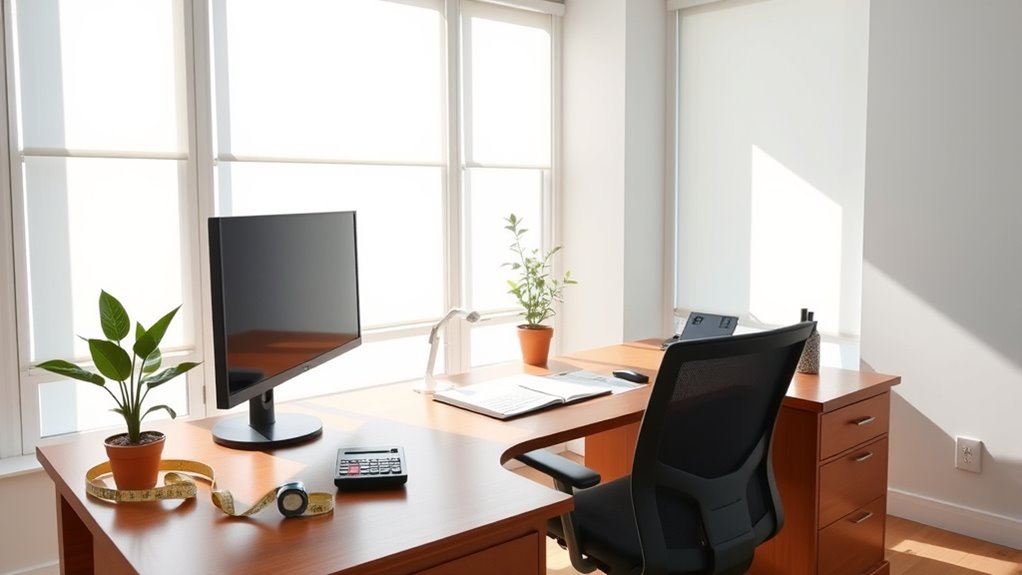
Before buying any ergonomic office equipment, you should evaluate your available space and establish a realistic budget. Start by assessing how much room you have for a desk, chair, and other essentials, ensuring your setup doesn’t feel cramped. Consider space utilization to determine what pieces fit best without overcrowding. Simultaneously, focus on budget planning to prioritize your needs and avoid overspending. Decide how much you’re willing to invest upfront, balancing quality with affordability. Keep in mind that a well-planned space and budget help you make smarter choices, preventing costly mistakes later. Additionally, incorporating space and organization techniques can optimize your area and enhance overall comfort. By understanding your space limitations and financial boundaries early on, you set a solid foundation for creating a comfortable, functional, and ergonomic home office.
Choosing the Right Desk and Chair for Comfort and Support
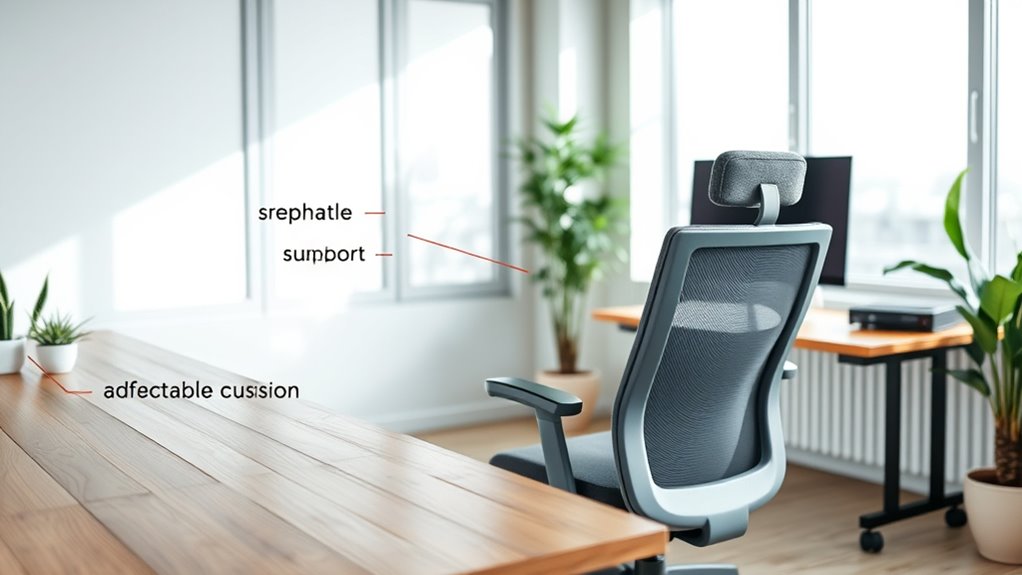
Choosing the right desk and chair is key to staying comfortable and focused. Look for ergonomic desk features like adjustable heights and enough surface space, while an adjustable chair supports good posture. When you match your chair and desk to your body’s needs, proper height alignment becomes effortless. Incorporating cozy textiles such as cushions or lumbar supports can further enhance comfort during long work sessions.
Ergonomic Desk Features
Selecting the right desk and chair is essential for creating an ergonomic home office that promotes comfort and reduces strain. Focus on ergonomic desk features like adjustable height, ample surface space, and sturdy support. When considering desk material selection, choose durable materials such as wood or metal that provide stability and longevity. A well-designed desk minimizes awkward postures and supports proper arm and wrist alignment. Additionally, incorporating self-watering plant pots can enhance the workspace environment by improving air quality and adding a touch of nature. Here’s a quick comparison:
| Feature | Material Options | Benefits |
|---|---|---|
| Adjustable height | Wooden, metal, laminate | Customizable for different users |
| Surface area | Glass, wood, laminate | Plenty of space for work tasks |
| Stability | Metal, thick wood | Prevents wobbling or tipping |
| Cable management | Metal, laminate | Keeps workspace organized |
| Durability | Solid wood, metal | Lasts for years |
Adjustable Chair Benefits
An adjustable chair offers tailored support that enhances comfort and helps prevent musculoskeletal issues during long work hours. With ergonomic chair features like adjustable height, lumbar support, and armrests, you can customize the chair to fit your body perfectly. The adjustable seating benefits ensure proper posture, reducing strain on your neck, back, and shoulders. When you can modify seat height, tilt, and backrest position, you’re more likely to maintain a natural spinal curve and stay comfortable throughout the day. This flexibility promotes better circulation and minimizes fatigue. Incorporating sound design principles such as clarity and appropriate sound cues into your workspace environment can further enhance focus and productivity. Investing in a chair with these adjustable features allows you to create a supportive, ergonomic setup that adapts to your needs, making your home office more comfortable and conducive to productivity.
Proper Height Alignment
To guarantee ideal comfort and support in your home office, proper height alignment between your desk and chair is essential. When your chair and desk are correctly aligned, posture correction becomes easier, reducing strain on your neck, shoulders, and back. Ensure your chair height allows your feet to rest flat on the floor, with knees at a 90-degree angle. Your elbows should be close to your body and form roughly a 90-degree angle when typing or using the mouse. The top of your monitor should be at eye level to promote ergonomic alignment. Adjusting your chair and desk to these specifications helps prevent discomfort and long-term musculoskeletal issues, making your workspace more efficient and comfortable. Proper height alignment is a simple yet critical step in creating an ergonomic home office. Incorporating AI safety measures can help monitor and optimize ergonomic setups for better health outcomes.
Ergonomic Keyboard and Mouse Setup
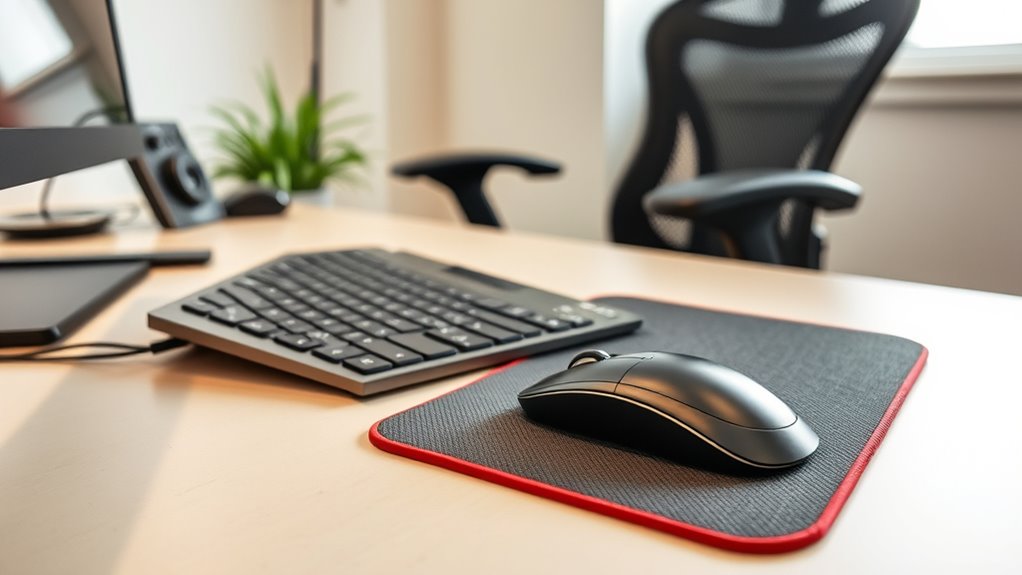
Setting up your keyboard and mouse correctly helps prevent strain and discomfort. Make sure your keyboard is at the right height, so your wrists stay straight, and use wrist supports if needed. Keep your mouse close and at the same level to reduce unnecessary reaching and maintain good posture. Additionally, adjusting your ergonomic setup can further enhance comfort and reduce fatigue during long work sessions.
Proper Keyboard Height
Ensuring your keyboard is at the proper height is essential for maintaining comfort and preventing strain during work. When your keyboard is positioned correctly, you’ll promote good typing posture and reduce the risk of discomfort. Ideally, your keyboard should be level with your elbows, allowing your arms to relax naturally. This prevents you from hunching or reaching upward, which can cause tension. Use this table to visualize ideal keyboard positioning:
| Hand Position | Elbow Angle | Comfort Level |
|---|---|---|
| Relaxed | 90-110° | High |
| Slightly Elevated | 80-100° | Moderate |
| Slightly Lower | 100-120° | Comfortable |
Maintaining proper keyboard height supports productivity and long-term health. Additionally, choosing ergonomic keyboard and mouse setups can further enhance comfort and reduce strain throughout your workday.
Wrist Support Strategies
Using ergonomic keyboards and mice is essential for providing proper wrist support and reducing strain during work. To enhance support, consider wearing a wrist brace during long sessions, especially if you experience discomfort. Additionally, placing your keyboard and mouse on ergonomic mats helps maintain a neutral wrist position and absorbs shock. Adjust your keyboard height so your wrists stay straight and avoid bending upward or downward. Keep your wrists relaxed and avoid resting them on hard surfaces for extended periods. Regular breaks and wrist stretches also prevent fatigue. By combining these strategies—using wrist braces when needed, utilizing ergonomic mats, and maintaining proper positioning—you can considerably reduce wrist strain and promote comfort throughout your workday. Incorporating awareness of toilet maintenance and proper disposal habits in your environment can also contribute to overall ergonomic well-being.
Mouse Placement Tips
Proper mouse placement plays a key role in maintaining ergonomic comfort during your workday. To optimize mouse positioning, keep it close to your keyboard and at the same height, so you don’t have to reach or strain your arm. Your wrist should be in a neutral position, not bent up or down, which helps improve cursor ergonomics and reduces discomfort. Use a mouse pad with wrist support if needed, and consider an ergonomic mouse design that fits comfortably in your hand. Make sure your forearm is parallel to the ground, and avoid resting your wrist on hard surfaces for extended periods. Adjusting your mouse placement regularly can prevent repetitive strain and promote better cursor ergonomics, supporting a healthier and more efficient work routine. Additionally, choosing the right type of headphones can enhance your focus and reduce external distractions during work.
Optimal Monitor Placement and Screen Ergonomics
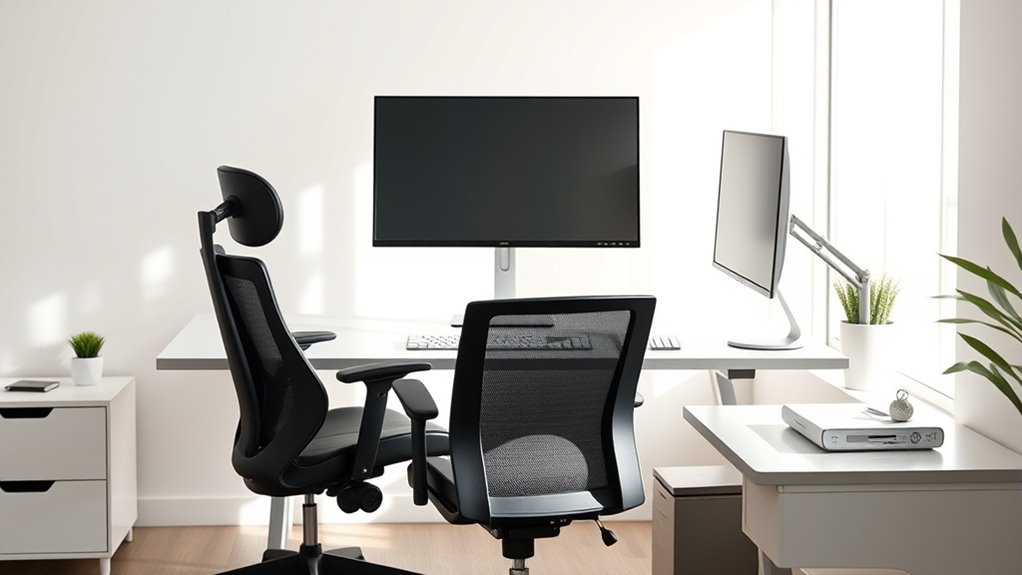
To minimize strain and maximize comfort, you should carefully position your monitor so that the top of the screen is at or just below eye level. Adjust the monitor height so that your eyes naturally gaze slightly downward when looking at the screen. Keep the screen distance about an arm’s length away, typically 20-30 inches, to reduce eye fatigue. Confirm the monitor is directly in front of you, avoiding turning your neck or torso. Tilt the screen slightly for ideal viewing angles and to prevent glare. Proper monitor placement helps maintain a neutral neck and shoulder position, reducing discomfort over long work hours. Regularly reassess your setup to confirm your monitor height and screen distance continue to support ergonomic health. Being aware of supermarket hours can also help streamline your shopping trips and reduce unnecessary trips to stores.
Proper Lighting to Reduce Eye Strain and Boost Focus
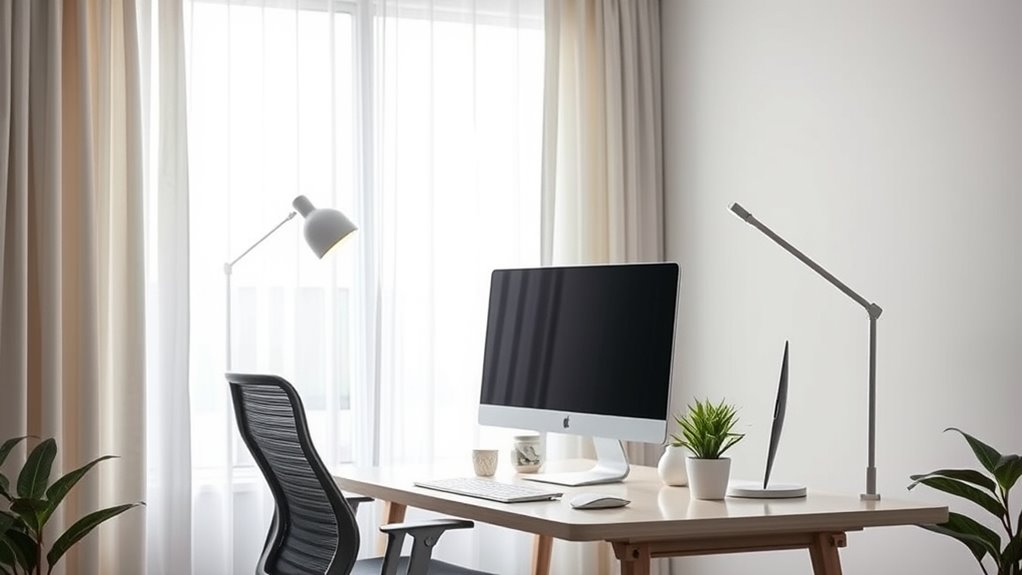
Ensuring your workspace is well-lit can considerably reduce eye strain and help you stay focused throughout the day. Proper lighting involves balancing ambient light with task lighting to create a comfortable environment. To optimize your lighting setup, consider these tips:
- Use adjustable task lighting to focus light directly on your work area, minimizing eye fatigue.
- Incorporate glare reduction techniques, such as matte screens or positioning lights away from your monitor.
- Avoid harsh overhead lighting by using softer, diffused light sources to prevent shadows and reflections.
- Selecting vetted lighting solutions made from durable materials can ensure safety and longevity in your workspace.
Organizing Your Workspace for Efficiency and Comfort
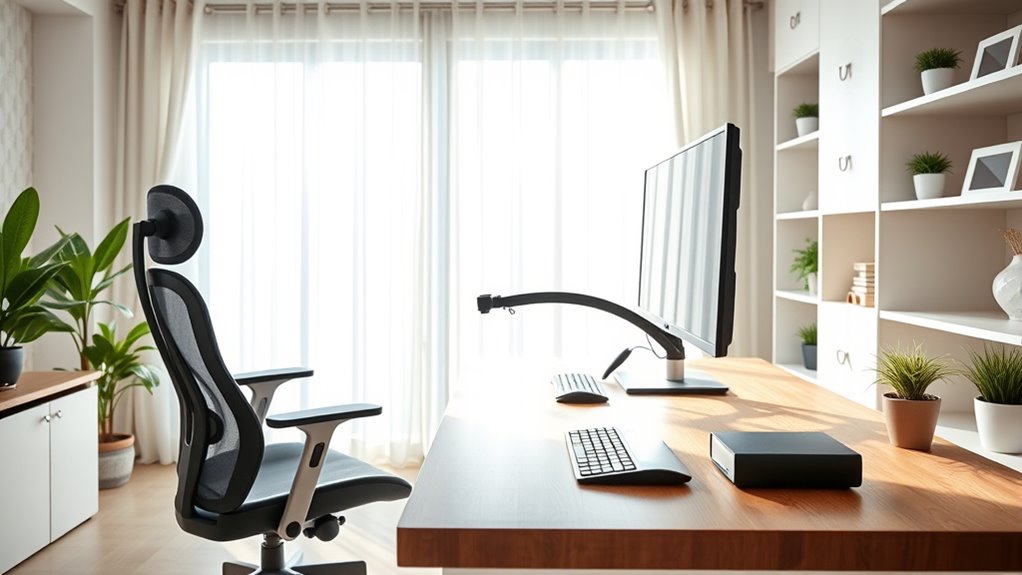
A well-organized workspace can dramatically boost your productivity and comfort during work hours. Start by optimizing desk organization—keep essential items within reach and clear clutter to reduce distractions. Use storage solutions like trays or drawers to maintain a tidy surface. Equally important is your chair cushioning; a comfortable, well-padded chair supports good posture and prevents discomfort during long hours. Adjust your chair height so your feet rest flat on the floor, and your knees are at a 90-degree angle. Keep frequently used tools nearby, and create designated zones for different tasks. A clean, organized environment minimizes stress and helps you stay focused, making your home office a more efficient and comfortable space to work in every day. Incorporating ergonomic office chairs can further enhance comfort and reduce strain during extended work sessions.
Incorporating Movement and Breaks Into Your Routine
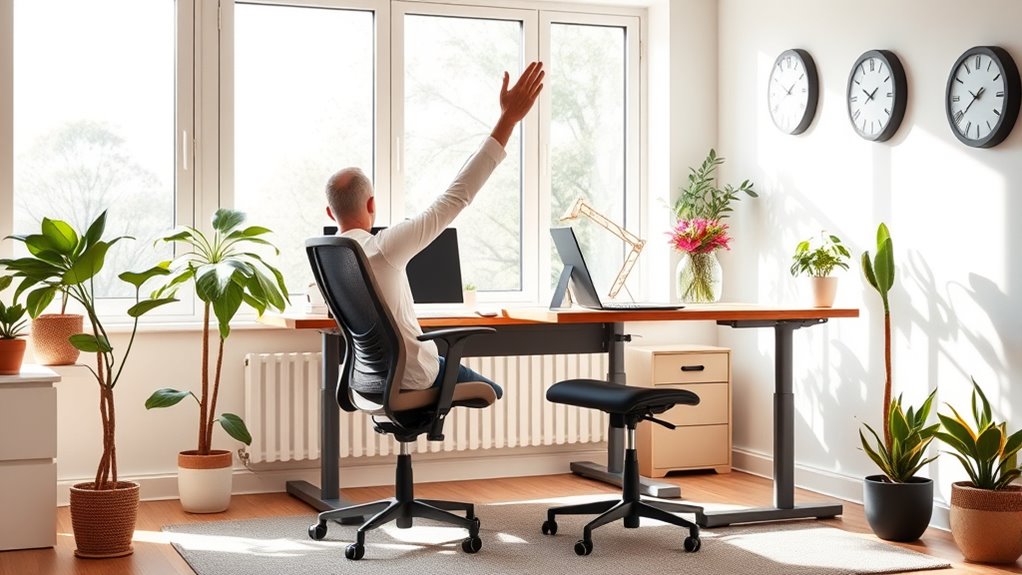
To stay productive and avoid discomfort, you should schedule regular breaks and stick to them. Incorporate stretching exercises and active tasks into your routine to keep your body moving. These small changes can make a big difference in your overall comfort and focus. Additionally, being aware of narcissistic behaviors can help you recognize and set boundaries around manipulative or unhealthy interactions that may disrupt your focus or well-being.
Scheduled Break Intervals
Have you ever noticed how staying seated for hours can drain your energy? To stay productive and comfortable, it’s essential to schedule regular break intervals. Properly managing break frequency helps prevent fatigue and reduces discomfort. Aim for a routine that includes:
- Taking a break every 60 minutes to reset your focus.
- Keeping rest durations between 5-10 minutes to avoid overextending downtime.
- Using breaks for movement, like walking or light activity, to boost circulation.
- Incorporating ergonomic adjustments into your workspace can further enhance comfort and reduce strain during long periods of sitting.
Stretching Exercises Regularly
Since staying still for long periods can cause stiffness and reduce circulation, incorporating regular stretching exercises into your routine is essential. Stretching routines and flexibility exercises help prevent discomfort and improve your posture. Take short breaks every hour to perform simple stretches like neck rolls, shoulder shrugs, or hamstring stretches. These quick movements boost circulation and keep your muscles relaxed. To stay organized, try following this routine:
| Stretching Exercise | Duration |
|---|---|
| Neck rolls | 30 seconds |
| Shoulder shrugs | 30 seconds |
| Wrist stretches | 30 seconds |
| Back twists | 30 seconds |
| Leg stretches | 30 seconds |
Consistency makes a difference—incorporate these into your daily schedule for ideal comfort. Remember, understanding the Vortex can help you align your mindset and enhance your well-being as you establish your ergonomic workspace.
Incorporate Active Tasks
Incorporating active tasks into your daily routine helps break up long periods of sitting and keeps your body moving. To do this effectively, consider alternating between sitting and standing using a standing desk. This reduces strain and boosts circulation. Additionally, use ergonomic footrests to improve posture and encourage subtle movement. Here are three ways to incorporate active tasks:
- Switch between sitting and standing every 30 minutes at your standing desk.
- Take short breaks every hour to stretch or walk around.
- Incorporate small movements, like shifting your weight or ankle circles, while seated with your ergonomic footrest.
- Exploring crochet styles for locs or practicing simple crochet techniques can provide a gentle, engaging activity during breaks, promoting both mental relaxation and fine motor skills.
These habits help prevent stiffness, promote better circulation, and enhance focus throughout your workday. Staying active is essential for an ergonomic home office.
Using Ergonomic Accessories to Enhance Comfort
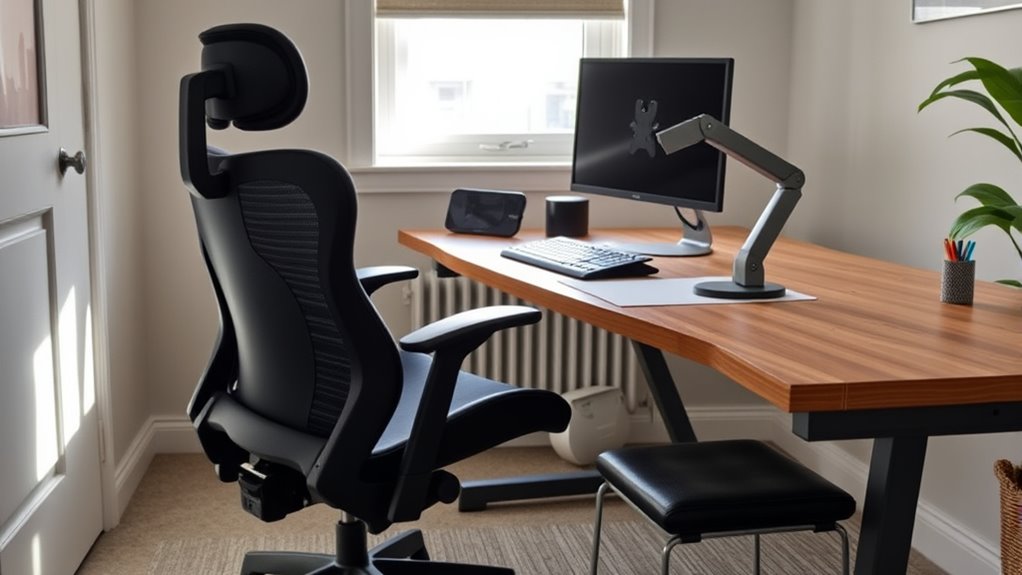
Using ergonomic accessories can substantially boost your comfort and productivity during long work hours. These tools, such as ergonomic mouse pads, wrist rests, and footrests, are designed to support your body’s natural posture and reduce strain. By incorporating ergonomic accessories into your setup, you’ll experience enhanced comfort, which helps prevent fatigue and discomfort. For example, a supportive keyboard tray or adjustable monitor stand ensures proper alignment, minimizing neck and eye strain. These accessories also promote better circulation and reduce repetitive stress injuries. Additionally, understanding business trends can help you make informed choices about which ergonomic products to invest in, ensuring your home office remains both functional and comfortable. With comfort enhancement as a priority, investing in ergonomic accessories allows you to work more efficiently and comfortably. Small adjustments with the right tools make a meaningful difference in creating a healthier, more sustainable home office environment.
Adjusting and Personalizing Your Workspace for Maximum Productivity
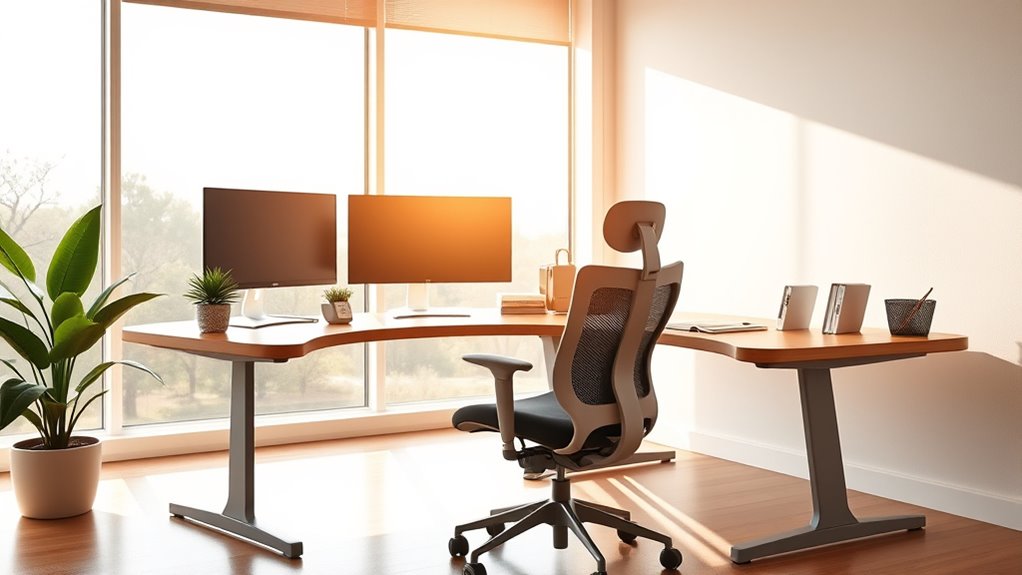
Personalizing your workspace can considerably boost your productivity by making it more comfortable and suited to your needs. Personalization options allow you to create an environment that motivates and supports you throughout the day. To optimize workspace customization, consider these three tips:
- Add personal touches, like photos or artwork, to inspire you.
- Use adjustable lighting to reduce eye strain and set the right mood.
- Incorporate ergonomic accessories that fit your workflow, ensuring comfort and efficiency.
- Consider vegetable juices or other healthy habits to maintain energy and focus during work hours.
Maintaining Ergonomic Habits for Long-Term Well-Being
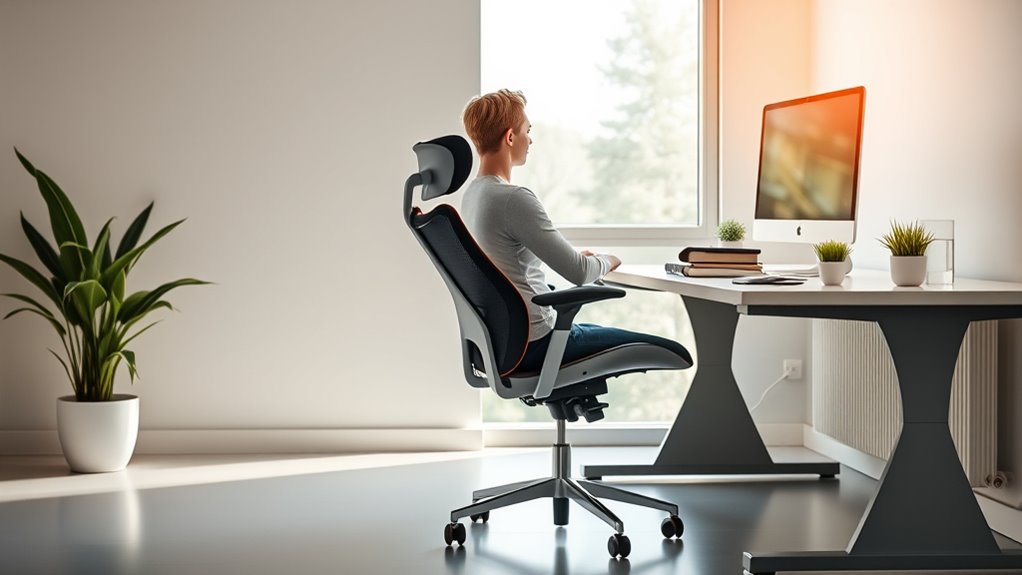
Maintaining ergonomic habits is essential for your long-term well-being, especially as you spend more hours working from home. To do this, stay mindful of your posture awareness throughout the day. Regularly check in with yourself to ensure your back is straight, shoulders relaxed, and feet flat on the floor. Developing consistent ergonomic habits, like taking short breaks to stretch and adjusting your chair and monitor height, helps prevent strain and discomfort. Remember, small, deliberate actions reinforce good posture and reduce the risk of long-term issues. Making these habits a routine keeps your body properly aligned and promotes overall health. By consciously practicing ergonomic habits, you’ll support your well-being today and well into the future.
Frequently Asked Questions
How Can I Make My Home Office More Ergonomic on a Tight Budget?
You want to make your home office more ergonomic on a tight budget, so try budget-friendly tips like adjusting your chair and monitor height with DIY ergonomic hacks. Use household items like books to raise your monitor or a cushion to support your lower back. Take regular breaks and stretch to reduce strain. These simple, cost-effective adjustments can markedly improve your comfort without spending much.
What Are Signs My Current Setup Is Causing Discomfort or Injury?
Ever wonder if your setup is hurting you? You might notice posture problems like slouching or leaning forward, which cause discomfort over time. Repetitive strain injuries from constant typing or mouse use can also develop, leading to pain or numbness. If you experience frequent headaches, sore wrists, or backaches, your current arrangement could be the culprit. Pay attention to these signs—they’re clues your workspace needs adjustments to prevent injury.
How Often Should I Adjust My Ergonomic Setup Over Time?
You should modify your ergonomic setup regularly to maintain comfort and prevent injury. Aim for an ergonomic assessment every few months, or whenever you notice discomfort or new symptoms. Adjust frequency depends on how often your work environment or body changes. Keep an eye on your posture, and if you experience pain or fatigue, update your setup immediately. Consistent adjustments help ensure your workspace stays supportive and ergonomic over time.
Are There Specific Ergonomic Tools Recommended for Small Spaces?
Think of your small space as a tiny garden needing clever tools. You’ll want compact furniture that fits comfortably without clutter, and space-saving accessories that maximize every inch. Items like foldable desks, wall-mounted monitors, or adjustable laptop stands work wonders. These ergonomic tools help you create a comfortable setup without sacrificing space, allowing you to work efficiently and maintain good posture, even in the smallest home offices.
How Can I Personalize My Workspace Without Compromising Ergonomics?
You can personalize your workspace without sacrificing ergonomics by choosing decorative accessories that don’t interfere with your setup, like sleek desk organizers or inspiring artwork. Incorporate personalized lighting options, such as adjustable desk lamps, to add a cozy touch while maintaining proper illumination. Keep everything within easy reach to avoid strain, and select items that support good posture, ensuring your space feels uniquely yours without compromising comfort or efficiency.
Conclusion
Creating an ergonomic home office might seem costly or time-consuming, but it’s an investment in your health and productivity. Imagine your space with a supportive chair, an adjustable monitor at eye level, and a cozy spot for breaks—it’s doable! By prioritizing comfort and making small adjustments, you’ll reduce strain and boost focus daily. Start simple, stay consistent, and watch your workspace transform into a healthy, efficient environment you’ll enjoy working in.
